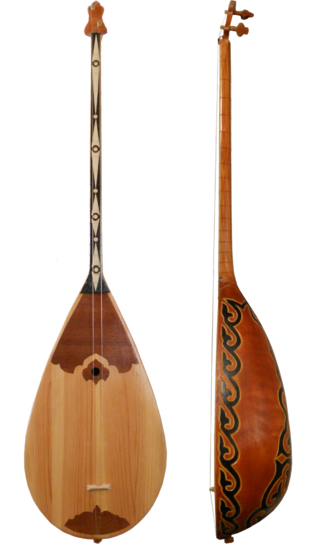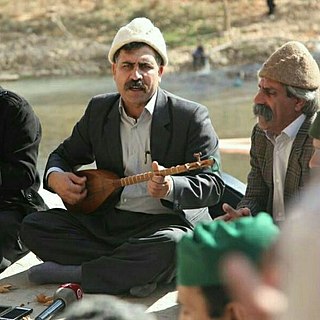Sources
- JSTOR: Buz- Baz: A Musical Marionette of Northern Afghanistan by Mark Slobin
- Tea house music by Mark Slobin at http://afghanistan.wesleyan.edu Archived 2011-01-04 at the Wayback Machine
Buz- baz is a musical puppetry tradition found in northern Afghanistan. The puppet is a goat which is controlled by a string connected to the wrist of the puppeteer. The goat is completely carved out of wood and made out of sequins and baubles and sometimes bells. The goat stands for two things. One is markhor, which means snake-eating goat of Badakhshan, and the ancient belief that mountain goats had powers.
Along with the goat, there is traditional Afghan music that plays during the performance. The goat is in beat with the music because it is connected to an instrument called the dambura. This is possible because the goat is on a platform that has a string connected through a pipe to the instrument. So not only is the puppeteer in control of the goat but also plays the dambura at the same time.

String instruments, stringed instruments, or chordophones are musical instruments that produce sound from vibrating strings when a performer plays or sounds the strings in some manner.

Puppetry is a form of theatre or performance that involves the manipulation of puppets – inanimate objects, often resembling some type of human or animal figure, that are animated or manipulated by a human called a puppeteer. Such a performance is also known as a puppet production. The script for a puppet production is called a puppet play. Puppeteers use movements from hands and arms to control devices such as rods or strings to move the body, head, limbs, and in some cases the mouth and eyes of the puppet. The puppeteer sometimes speaks in the voice of the character of the puppet, while at other times they perform to a recorded soundtrack.

The Dombra, also known as Dombyra or Tambura is a long-necked musical string instrument used by the Kazakhs, Uzbeks, Turkmens, Hazaras, Bashkirs and Nogais in their traditional folk music. The Dombura shares certain characteristics with the komuz and dutar instruments, such as its long, thin neck and oblong body shape. It is a popular instrument mostly among Turkic and Iranic communities in Central Asian countries such as Kazakhstan, Uzbekistan, Tajikistan, Turkmenistan and Afghanistan.

A marionette is a puppet controlled from above using wires or strings depending on regional variations. A marionette's puppeteer is called a marionettist. Marionettes are operated with the puppeteer hidden or revealed to an audience by using a vertical or horizontal control bar in different forms of theatres or entertainment venues. They have also been used in films and on television. The attachment of the strings varies according to its character or purpose.

The music of Afghanistan comprises many varieties of classical music, folk music, and modern popular music. Afghanistan has a rich musical heritage and features a mix of Persian melodies, Indian compositional principles, and sounds from ethnic groups such as the Pashtuns, Tajiks and Hazaras. Instruments used range from Indian tablas to long-necked lutes. Afghanistan's classical music is closely related to Hindustani classical music while sourcing much of its lyrics directly from classical Persian poetry such as Mawlana Balkhi (Rumi) and the Iranian tradition indigenous to central Asia. Lyrics throughout most of Afghanistan are typically in Dari (Persian) and Pashto. The multi-ethnic city of Kabul has long been the regional cultural capital, but outsiders have tended to focus on the city of Herat, which is home to traditions more closely related to Iranian music than in the rest of the country.
A slur is a symbol in Western musical notation indicating that the notes it embraces are to be played without separation. A slur is denoted with a curved line generally placed over the notes if the stems point downward, and under them if the stems point upwards.
Prime functions of the slur in keyboard music...are to delineate the extent of a phrase line and to indicate the legato performance of melodies or arpeggiated chords.
Both accents and slurs relate directly to woodwind articulation...(and brass as well) [since they] employ a variety of tonguing effects [which are indicated by use of, "the correct form," of accents and slurs].
[With bowed string instruments] A curved slur over or under two or more notes indicates that these notes are to be connected...Slurs are only partially indicative of phrasing; if an actual phrase mark is necessary, it should be notated above the passage with broken lines.

The Kafir harp is a traditional four- or five-stringed arched harp used by the Nuristanis native to the Nuristan Province of northeastern Afghanistan and Lower Chitral District of northwestern Pakistan. It is played during social gatherings, and to accompany epic storytelling or songs of heroic tales.

Safdar Tawakoli ; is an ethnic Hazara musician from Afghanistan. He focuses on and plays mostly Hazara folkloric and regional traditional music based on the dambura. In 2020 the Afghan government awarded him the title of "Sultan Dambura" for his unique musical style.

An experimental musical instrument is a musical instrument that modifies or extends an existing instrument or class of instruments, or defines or creates a new class of instrument. Some are created through simple modifications, such as cracked cymbals or metal objects inserted between piano strings in a prepared piano. Some experimental instruments are created from household items like a homemade mute for brass instruments such as bathtub plugs. Other experimental instruments are created from electronic spare parts, or by mixing acoustic instruments with electric components.

Rubab, Robab or Rabab is a lute-like musical instrument. The rubab, one of the national musical instruments of Afghanistan, is also commonly played in Pakistan and India by Pashtuns, Balochis, Sindhis, Kashmiris and Punjabis. The rubab has three variants, the Kabuli rebab of Afghanistan, the Rawap of Xinjiang, the Pamiri rubab of Tajikistan and the seni rebab of northern India. The instrument and its variants spread throughout West, Central, South and Southeast Asia. The Kabuli rebab from Afghanistan derives its name from the Arabic rebab and is played with a bow while in Central Asia and the Indian subcontinent, the instrument is plucked and is distinctly different in construction.

The term Tanbur can refer to various long-necked string instruments originating in Mesopotamia, Southern or Central Asia. According to the New Grove Dictionary of Music and Musicians, "terminology presents a complicated situation. Nowadays the term tanbur is applied to a variety of distinct and related long-necked lutes used in art and folk traditions. Similar or identical instruments are also known by other terms." These instruments are used in the traditional music of Iran, India, Kurdistan, Armenia, Afghanistan, Azerbaijan, Pakistan, Turkey, Tajikistan, Kazakhstan, and Uzbekistan.

A puppet is an object, often resembling a human, animal or mythical figure, that is animated or manipulated by a person called a puppeteer. Puppetry is an ancient form of theatre which dates back to the 5th century BC in Ancient Greece.
The zerbaghali is a goblet-shaped hand drum that is played in the folk music of Afghanistan.

The temir komuz is a Kyrgyz jaw's harp, while the komuz is a three-stringed fretless lute. As an instrument, the temir komuz is unrelated to the komuz in terms of style and structure; however, it takes its name from the other popular Turkic instrument.

Afghan art has spanned many centuries. In contrast to its independence and isolation in recent centuries, ancient and medieval Afghanistan spent long periods as part of large empires, which mostly also included parts of modern Pakistan and north India, as well as Iran. Afghan cities were often sometimes among the capitals or main cities of these, as with the Kushan Empire, and later the Mughal Empire. In addition some routes of the Silk Road to and from China pass through Afghanistan, bringing influences from both the east and west.
The rawap or rubab is an Eastern Iranian fretted plucked long-necked stringed instrument also used in folk music by residents of the Uyghur autonomous region of Xinjiang, Western China. The history of the instrument dates back to the Ancient Iran including modern Tajikistan and spreading in the 14th century to Turkic cultures including southern Xinjiang. It is an instrument of the Tajiks also used in Uzbekistan. It's particularly associated with Tajik music and culture including Tajiks of Bukhara and Samarkand.
Hazara culture refers to the culture and tradition of the Hazara people, who live primarily in the Hazarajat region of central Afghanistan, the Balochistan province of Pakistan, and elsewhere around the world where the Hazara diaspora is settled as part of the wider Afghan diaspora.
Mir Maftoon also written as Mehri Maftun, is an Afghan musician. Born 1962s in Badakhshan.

Music technology is the study or the use of any device, mechanism, machine or tool by a musician or composer to make or perform music; to compose, notate, playback or record songs or pieces; or to analyze or edit music.

Zang means bell in Persian, for both large bells and small. The term has historically been applied to a number of ringing metal musical instruments, including large bells with clappers worn by elephants, smaller 3-9 inch bells worn on camels, horses, donkeys and cattle, 2-3 inch sheep bells, and tiny bells tied to the legs of hawks. It also applies to clusters of small bells worn by musicians and dancers, sewn onto cloth bracelets and anklets, or laced on a long string to be wrapped around the waist or hung as a necklace.